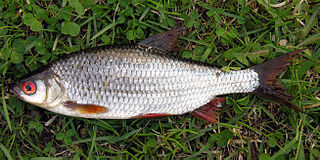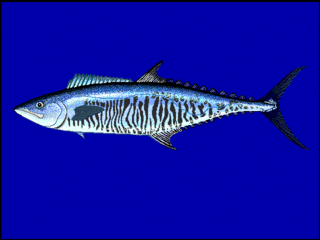
Gadiformes are an order of ray-finned fish, also called the Anacanthini, that includes the cod. Many major food fish are in this order. They are found in marine waters throughout the world and the vast majority of the species are found in temperate or colder regions. A few species may enter estuaries but only one, the burbot, is a freshwater fish.

The milkfish is the sole living species in the family Chanidae, but at least five extinct genera from the Cretaceous have been found. The repeating scientific name (tautonym) is from Greek khanos.

The roach, or rutilus roach, also known as the common roach, is a fresh- and brackish-water fish of the family Cyprinidae, native to most of Europe and western Asia. Fish called roach can be any species of the genera Rutilus and Hesperoleucus, depending on locality. The plural of the term is also roach.

Pelagic fish live in the pelagic zone of ocean or lake waters—being neither close to the bottom nor near the shore—in contrast with demersal fish that do live on or near the bottom, and reef fish that are associated with coral reefs.

Demersal fish, also known as groundfish, live and feed on or near the bottom of seas or lakes. They occupy the sea floors and lake beds, which usually consist of mud, sand, gravel or rocks. In coastal waters they are found on or near the continental shelf, and in deep waters they are found on or near the continental slope or along the continental rise. They are not generally found in the deepest waters, such as abyssal depths or on the abyssal plain, but they can be found around seamounts and islands. The word demersal comes from the Latin demergere, which means to sink.

The bigeye thresher is a species of thresher shark, family Alopiidae, found in temperate and tropical oceans worldwide. Like the other thresher sharks, nearly half its total length consists of the elongated upper lobe of the tail fin. Its common name comes from its enormous eyes, which are placed in keyhole-shaped sockets that allow them to be rotated upward. This species can also be distinguished by a pair of deep grooves on the top of its head, from which its scientific name is derived.

Waders denotes a waterproof boot or overalls extending from the foot to the thigh, the chest or the neck. They are traditionally made from vulcanised rubber, but available in more modern PVC, neoprene and Gore-Tex variants. Waders are generally distinguished from counterpart waterproof boots by shaft height; the hip boot extending to the thigh and the Wellington boot to the knee. For the sake of emphasis, therefore, waders are sometimes defined by the extent of their coverage as thigh waders, chest waders or full-body waders. As a drysuit variant, full-body waders come with leaktight cuffs or gloves fitted to the sleeves and with a leaktight collar or hood fitted to the neck, enabling the wearer to remain dry when standing or walking in deeper water. Waders are available with boots attached or can have attached stocking feet, to wear inside boots, or inside swimfins in the case of float tube fishing.

The smalleye pygmy shark is a little-known species of squaliform shark in the family Dalatiidae, found in water 150–2,000 m (490–6,560 ft) deep near Japan, the Philippines, and Australia. It migrates vertically daily, spending the day in deep water and the night in shallower water. One of the smallest shark species, the smalleye pygmy shark is known to reach only 22 cm (8.7 in) long. It has a blackish, spindle-shaped body with relatively small eyes, and a spine preceding the first dorsal fin, but not the second. Bioluminescent photophores occur on its underside, which may serve to disguise its silhouette from predators. This species feeds on small squid, krill, shrimp, and bony fishes. It is aplacental viviparous. The International Union for Conservation of Nature has assessed it as Least Concern, citing its wide distribution and lack of threat from fisheries.

The gecko catshark is a species of catshark, part of the family Scyliorhinidae, native to the northwestern Pacific Ocean from southern Japan to Taiwan, and possibly also off Vietnam. It is a common, demersal species found at depths of 100–900 m (330–2,950 ft). Its body is slender, with a pattern of dark saddles and blotches. The dorsal and caudal fins are edged in white, and there is a prominent crest of enlarged dermal denticles along the dorsal edge of the caudal fin. The gecko catshark is a schooling, opportunistic predator of bony fishes, cephalopods, and crustaceans. It is oviparous, with females producing two vase-shaped egg capsules at a time. This species is captured as bycatch, but does not appear to be threatened by fishery activities at present and has been assessed as Least Concern by the International Union for Conservation of Nature (IUCN).
Bathygadus garretti is a species of rattail. This is a deep-water fish found in the waters around southern Japan and northern Taiwan.
Bathygadus nipponicus is a species of rattail. This is a deep-water fish found in the waters around southern Japan and northern Taiwan.
The arrowtooth grenadier is a species of rattail. This is a deep-water fish found at depths of up to 950 m. It was originally recorded from the waters around Hawaii but has recently also been recorded near Taiwan, which suggests it has a far wider distribution than previously thought.

The giant trevally, also known as the lowly trevally, barrier trevally, ronin jack, giant kingfish, or ulua, is a species of large marine fish classified in the jack family, Carangidae. The giant trevally is distributed throughout the tropical waters of the Indo-Pacific region, with a range stretching from South Africa in the west to Hawaii in the east, including Japan in the north and Australia in the south. Two were documented in the eastern tropical Pacific in the 2010s, but whether the species will become established there remains to be seen.

The tawny fish owl is a fish owl species in the family known as typical owls, Strigidae. It is native from southern Nepal to Bangladesh, Vietnam and China. Due to its wide geographical distribution, it is listed as Least Concern on the IUCN Red List.

The narrow-barred Spanish mackerel is a mackerel of the family Scombridae found in a wide-ranging area in Southeast Asia, but as far west as the east coast of Africa and from the Middle East and along the northern coastal areas of the Indian Ocean, and as far east as the South West Pacific Ocean.

The rainbow runner, also known as the rainbow yellowtail, Spanish jack and Hawaiian salmon, is a common species of pelagic marine fish of the jack family, Carangidae. The species is widespread throughout the tropical and subtropical waters of the world, inhabiting both coastal and offshore areas. The species is the only member of the genus Elagatis, which was created 15 years after its initial description, and is closely related to the amberjacks. The rainbow runner is easily distinguished by its body shape, and the brilliant colouration which gives the fish its name. It is a fast-swimming predator, taking small fish, cephalopods, and a wide variety of planktonic crustaceans. The species reaches sexual maturity around 60 cm (24 in), and spawning takes place at different times, with some populations spawning year round, while others only spawn at certain times of the year. The species is a well known game fish, taken by a variety of fishing methods, and is a well-regarded table fish. Large numbers of the species are taken as bycatch in tuna- and shark-fishing operations and marketed.

Coastal fish, also called inshore fish or neritic fish, inhabit the sea between the shoreline and the edge of the continental shelf. Since the continental shelf is usually less than 200 metres (660 ft) deep, it follows that pelagic coastal fish are generally epipelagic fish, inhabiting the sunlit epipelagic zone. Coastal fish can be contrasted with oceanic fish or offshore fish, which inhabit the deep seas beyond the continental shelves.

Pom Pom Island is a small coral reef island in the Celebes Sea approximately 30 kilometres north east of Semporna town, Sabah, East Malaysia.

The stripey, also known as the footballer or convict fish, is a species of ray-finned fish, a sea chub from the subfamily Microcanthinae which is part of the family Kyphosidae. It is native to the Pacific Ocean where it has a wide range. This species may be found in the aquarium trade. It is the only known member of its genus.

Chaetodon nippon, also known as the Japanese butterflyfish, is a species of marine angelfish found in the northwest Pacific Ocean in the shallow seas around Japan, South Korea, the Philippines and Taiwan.

















